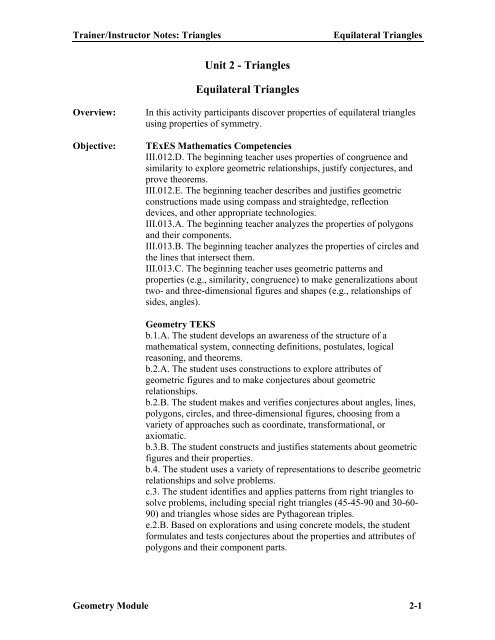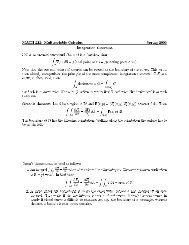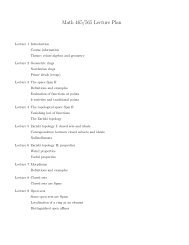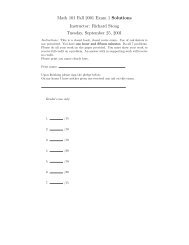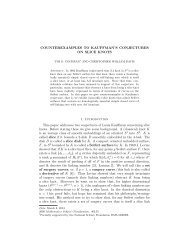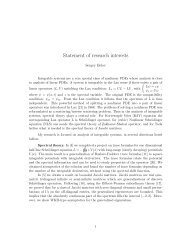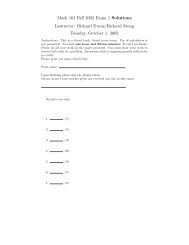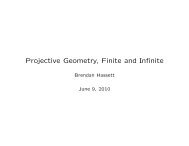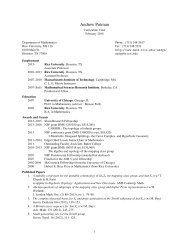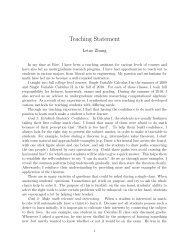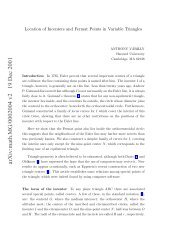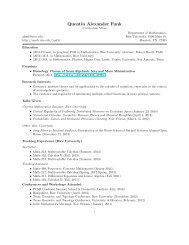Unit 2 - Triangles Equilateral Triangles
Unit 2 - Triangles Equilateral Triangles
Unit 2 - Triangles Equilateral Triangles
Create successful ePaper yourself
Turn your PDF publications into a flip-book with our unique Google optimized e-Paper software.
Trainer/Instructor Notes: <strong>Triangles</strong> <strong>Equilateral</strong> <strong>Triangles</strong><br />
<strong>Unit</strong> 2 - <strong>Triangles</strong><br />
<strong>Equilateral</strong> <strong>Triangles</strong><br />
Overview: In this activity participants discover properties of equilateral triangles<br />
using properties of symmetry.<br />
Objective: TExES Mathematics Competencies<br />
III.012.D. The beginning teacher uses properties of congruence and<br />
similarity to explore geometric relationships, justify conjectures, and<br />
prove theorems.<br />
III.012.E. The beginning teacher describes and justifies geometric<br />
constructions made using compass and straightedge, reflection<br />
devices, and other appropriate technologies.<br />
III.013.A. The beginning teacher analyzes the properties of polygons<br />
and their components.<br />
III.013.B. The beginning teacher analyzes the properties of circles and<br />
the lines that intersect them.<br />
III.013.C. The beginning teacher uses geometric patterns and<br />
properties (e.g., similarity, congruence) to make generalizations about<br />
two- and three-dimensional figures and shapes (e.g., relationships of<br />
sides, angles).<br />
Geometry TEKS<br />
b.1.A. The student develops an awareness of the structure of a<br />
mathematical system, connecting definitions, postulates, logical<br />
reasoning, and theorems.<br />
b.2.A. The student uses constructions to explore attributes of<br />
geometric figures and to make conjectures about geometric<br />
relationships.<br />
b.2.B. The student makes and verifies conjectures about angles, lines,<br />
polygons, circles, and three-dimensional figures, choosing from a<br />
variety of approaches such as coordinate, transformational, or<br />
axiomatic.<br />
b.3.B. The student constructs and justifies statements about geometric<br />
figures and their properties.<br />
b.4. The student uses a variety of representations to describe geometric<br />
relationships and solve problems.<br />
c.3. The student identifies and applies patterns from right triangles to<br />
solve problems, including special right triangles (45-45-90 and 30-60-<br />
90) and triangles whose sides are Pythagorean triples.<br />
e.2.B. Based on explorations and using concrete models, the student<br />
formulates and tests conjectures about the properties and attributes of<br />
polygons and their component parts.<br />
Geometry Module 2-1
Trainer/Instructor Notes: <strong>Triangles</strong> <strong>Equilateral</strong> <strong>Triangles</strong><br />
e.2.C. Based on explorations and using concrete models, the student<br />
formulates and tests conjectures about the properties and attributes of<br />
circles and the lines that intersect them.<br />
Background: Participants need a basic understanding of reflections, lines of<br />
reflection, lines of symmetry, and properties of similar figures.<br />
Materials: patty paper, straightedge compass, easel paper, colored markers<br />
New Terms: altitude, central angle, circumscribed circle, concentric circle,<br />
inscribed angle, inscribed circle, line of reflection or line of symmetry,<br />
median, perpendicular bisector<br />
Procedures:<br />
Distribute the activity sheet, easel paper, and markers to participants. Have them work for<br />
about 45 minutes, answering the questions individually on their own paper. Allow<br />
discussion with others when needed. Participants record their responses to 12 on a sheet<br />
of easel paper. During whole group discussion, ask one participant from each group to<br />
summarize the properties determined by his/her group. Ask other participants to add any<br />
properties omitted by earlier groups. Be careful to list all of the properties that appear<br />
below, including the connections to special right triangles, similar figures and circles<br />
from 10 and 11.<br />
T<br />
Complete 1-12 to explore the properties of equilateral triangles.<br />
1. Carefully construct a large equilateral triangle on patty paper<br />
using a straightedge and compass. Label ∆STV.<br />
2. List properties of equilateral triangles and mark the triangle to<br />
indicate the identified properties. Explain how you know these properties from the<br />
constructed triangle.<br />
Participants may write that equilateral triangles have equal side lengths and equal<br />
angle measures. These properties can be verified by folding the angles on top of each<br />
other.<br />
3. Fold, draw or construct the lines of symmetry/reflection on the patty paper triangle.<br />
Label the intersection of the lines of symmetry P.<br />
4. Label the intersection of the line of symmetry from vertex S<br />
to TV as A, the intersection of the line of symmetry from<br />
vertex V to TS as B, and the intersection of the line of<br />
symmetry from vertex T to SV as C.<br />
Geometry Module 2-2<br />
S<br />
S<br />
T<br />
B A<br />
C<br />
P<br />
V<br />
V
Trainer/Instructor Notes: <strong>Triangles</strong> <strong>Equilateral</strong> <strong>Triangles</strong><br />
5. Describe the relationship between the lines of symmetry and the vertex<br />
angles of the triangle. Mark these properties on the triangle. Label the<br />
measures of the angles created by the lines of symmetry. Based on<br />
these properties, what is another name for the lines of symmetry?<br />
The lines of symmetry can be called angle bisectors because the<br />
segments bisect the vertex angles, forming two 30 o angles.<br />
6. Describe the relationship between the lines of symmetry and the<br />
sides of the triangle. Mark the relationships on the triangle.<br />
The lines of symmetry bisect the sides of the triangle.<br />
TB ≅ SB; SC ≅VC; TA ≅ VA.<br />
The lines of symmetry are perpendicular to the sides of the<br />
<br />
triangle. VB ⊥TS; SA ⊥TV; TC ⊥ SV.<br />
7. Using the information now marked on the triangle, what are three other names which<br />
can be used to describe the segments lying on the lines of symmetry?<br />
Because the three lines of symmetry bisect the sides of the triangle at right angles, the<br />
segments lying on the lines of symmetry are also medians, altitudes and<br />
perpendicular bisectors. A median of a triangle is a segment connecting a vertex to<br />
the midpoint of the opposite side of the triangle. An altitude is a segment from a<br />
vertex, perpendicular to the opposite side. A perpendicular bisector is a segment that<br />
bisects another segment at a right angle.<br />
8. Use a ruler or patty paper to compare the lengths of the medians.<br />
The medians, which lie on the lines of symmetry, are congruent.<br />
9. Use a ruler or patty paper to compare the lengths of the longer and shorter segments<br />
that make up a median, for example, TP and PC . Find the ratio of their lengths. Why<br />
is the ratio the same for all three medians?<br />
The ratio of the longer to the shorter segment is 2:1. For example, TP = 2 • PC. This<br />
holds true for all of the medians because the symmetry properties ensure congruence<br />
for all of the longer segments and all of the shorter segments.<br />
10. Compare the six smaller right triangles and the six larger<br />
right triangles formed by the medians. Describe the<br />
relationship between the larger right triangles and the<br />
smaller right triangles.<br />
All of the right triangles have angle measures of 30 o , 60 o ,<br />
and 90 o . We call these 30°-60°-90° triangles. The larger<br />
and smaller right triangles are similar. Similar shapes<br />
have congruent angles, and proportional side lengths. In<br />
the large 30°-60°-90° triangle, the length of the hypotenuse, a side of the equilateral<br />
triangle, is twice the length of the short side, formed by the bisection of a side of the<br />
equilateral triangle. The relationship must exist for both the small and large<br />
triangles. This explains the 2:1 ratio for the medians.<br />
Geometry Module 2-3<br />
S<br />
S<br />
30°<br />
30°<br />
S<br />
30°<br />
30°<br />
T<br />
30° 30°<br />
B A<br />
30°<br />
30°<br />
C<br />
P<br />
T<br />
30° 30°<br />
30°<br />
30°<br />
B A<br />
T<br />
30° 30°<br />
C<br />
P<br />
B A<br />
C<br />
P<br />
30°<br />
30°<br />
30°<br />
30°<br />
V<br />
V<br />
V
Trainer/Instructor Notes: <strong>Triangles</strong> <strong>Equilateral</strong> <strong>Triangles</strong><br />
11. Using a compass, draw a circle inscribed in ∆TSV, radius PB .<br />
Draw a second circle circumscribed about ∆TSV, radius PT .<br />
Record the properties of an inscribed circle and a circumscribed<br />
circle for an equilateral triangle.<br />
The length of the radius of the circumscribed circle is twice<br />
the length of the radius of the inscribed circle in an<br />
equilateral triangle.<br />
The two circles have the same center; they are concentric<br />
30°<br />
30°<br />
30° 30°<br />
circles.<br />
∠SPV ≅ ∠TPV≅ ∠ TPS . These are central angles for the circumscribed circle,<br />
because their vertices are located at the center of the circle, and their sides are<br />
radii of the circle. ∠STV , ∠TSV , and ∠TVS are inscribed angles, intercepted by<br />
the same chords, SV , TV , and TS , as the central angles, in that order. Note that<br />
the measures of these central angles are 120 o , while the measures of the<br />
corresponding inscribed angles are 60 o . The measure of the central angle is equal<br />
to twice the measure of the inscribed angle intercepted by the same chord.<br />
12. On a sheet of easel paper, construct and label an equilateral triangle with the lines of<br />
symmetry, and the inscribed and circumscribed circles. List all of the properties of<br />
equilateral triangles.<br />
<strong>Equilateral</strong> triangles have congruent sides and congruent angles.<br />
<strong>Equilateral</strong> triangles have three lines of reflectional symmetry.<br />
The vertex angles measure 60 o .<br />
The three lines of symmetry bisect the vertex angles.<br />
The three segments that lie on the lines of symmetry are angle bisectors, altitudes,<br />
medians and perpendicular bisectors.<br />
The lines of symmetry divide the triangle into six larger and six smaller 30°-60°-<br />
90° triangles.<br />
The larger and smaller right triangles are similar.<br />
Within all 30°-60°-90° triangles, the length of the hypotenuse is twice the length<br />
of the short leg.<br />
The inscribed and circumscribed circles are concentric circles centered at the<br />
intersection of the lines of symmetry.<br />
The radius of the circumscribed circle is twice as long as the radius of the<br />
inscribed circle.<br />
The measure of a central angle is two times the measure of the inscribed angle<br />
intercepted by the same chord.<br />
At the end of the activity, facilitate a whole group discussion about the van Hiele levels<br />
used throughout the activity on equilateral triangles. Participants making observations in<br />
1 – 4 are performing on the Visual Level, using quick observation. With 5 – 12, the<br />
questions move participants to the Descriptive Level because an exhaustive list of<br />
properties is developed by further observation and measurement. Although the<br />
relationships between different properties are explored in these problems, the questions<br />
revolve around one triangle, the equilateral triangle.<br />
Geometry Module 2-4<br />
S<br />
T<br />
30° 30°<br />
B A<br />
C<br />
P<br />
V
Activity Page: <strong>Triangles</strong> <strong>Equilateral</strong> <strong>Triangles</strong><br />
<strong>Equilateral</strong> <strong>Triangles</strong><br />
Complete 1 – 12 to explore the properties of equilateral triangles.<br />
1. Carefully construct a large equilateral triangle on patty paper using ruler<br />
and compass. Label ∆STV.<br />
2. List properties of equilateral triangles and mark the triangle to indicate<br />
the identified properties. Explain how you know these properties from<br />
the constructed triangle.<br />
3. Fold, draw or construct the lines of symmetry/reflection on the patty<br />
paper triangle. Label the intersection of the lines of symmetry P.<br />
4. Label the intersection of the line of symmetry from vertex S to TV as A,<br />
the intersection of the line of symmetry from vertex V to TS as B, and the<br />
intersection of the line of symmetry from vertex T to SV as C.<br />
5. Describe the relationship between the lines of symmetry and the vertex<br />
angles of the triangle. Mark these properties on the triangle. Label the<br />
measures of the angles created by the lines of symmetry. Based on these<br />
properties, what is another name for the lines of symmetry?<br />
6. Describe the relationship between the lines of symmetry and the sides of<br />
the triangle. Mark the relationships on the triangle.<br />
7. Using the information now marked on the triangle, what are three other<br />
names which can be used to describe the segments lying on the lines of<br />
symmetry?<br />
Geometry Module 2-5
Activity Page: <strong>Triangles</strong> <strong>Equilateral</strong> <strong>Triangles</strong><br />
8. Use a ruler or patty paper to compare the lengths of the medians.<br />
9. Use a ruler or patty paper to compare the lengths of the longer and<br />
shorter segments that make up a median, for example, TP and PC . Find<br />
the ratio of their lengths. Why is the ratio the same for all three medians?<br />
10. Compare the six smaller right triangles and the six larger right triangles<br />
formed by the medians. Describe the relationship between the larger right<br />
triangles and the smaller right triangles.<br />
11. Using a compass, draw a circle inscribed in ∆TSV with radius PB . Draw<br />
a second circle circumscribed about ∆TSV with radius PT . Record the<br />
properties of an inscribed circle and a circumscribed circle for an<br />
equilateral triangle.<br />
12. On a sheet of easel paper, construct and label an equilateral triangle with<br />
the lines of symmetry and the inscribed and circumscribed circles. List all<br />
of the properties of equilateral triangles.<br />
Geometry Module 2-6
Trainer/Instructor Notes: <strong>Triangles</strong> Two Congruent Angles<br />
Two Congruent Angles<br />
Overview: Participants construct right, acute, and isosceles obtuse triangles using the<br />
radii of congruent circles to determine properties of isosceles triangles. An<br />
extension introduces and extends properties of circle segments and angles.<br />
Objective: TExES Mathematics Competencies<br />
III.012.D. The beginning teacher uses properties of congruence and<br />
similarity to explore geometric relationships, justify conjectures, and<br />
prove theorems.<br />
III.013.A. The beginning teacher analyzes the properties of polygons and<br />
their components.<br />
III.013.B. The beginning teacher analyzes the properties of circles and the<br />
lines that intersect them.<br />
III.013.C. The beginning teacher uses geometric patterns and properties<br />
(e.g., similarity, congruence) to make generalizations about two- and<br />
three-dimensional figures and shapes (e.g., relationships of sides, angles).<br />
V.018.D. The beginning teacher uses formal and informal reasoning to<br />
justify mathematical ideas.<br />
VI.020.A. The beginning teacher applies research-based theories of<br />
learning mathematics to plan appropriate instructional activities for all<br />
students.<br />
Geometry TEKS<br />
b.2.A. The student uses constructions to explore attributes of geometric<br />
figures and to make conjectures about geometric relationships.<br />
b.2.B. The student makes and verifies conjectures about angles, lines,<br />
polygons, circles, and three-dimensional figures, choosing from a variety<br />
of approaches such as coordinate, transformational, or axiomatic.<br />
b.3.B. The student constructs and justifies statements about geometric<br />
figures and their properties.<br />
c.1. The student uses numeric and geometric patterns to make<br />
generalizations about geometric properties, including properties of<br />
polygons, ratios in similar figures and solids, and angle relationships in<br />
polygons and circles.<br />
e.2.B. Based on explorations and using concrete models, the student<br />
formulates and tests conjectures about the properties and attributes of<br />
polygons and their component parts.<br />
e.2.C. Based on explorations and using concrete models, the student<br />
formulates and tests conjectures about the properties and attributes of<br />
circles and the lines that intersect them.<br />
Background: Participants must understand rotational symmetry.<br />
Materials: patty paper, straightedge, protractor, compass, easel paper, colored<br />
markers<br />
Geometry Module 2-7
Trainer/Instructor Notes: <strong>Triangles</strong> Two Congruent Angles<br />
New Terms:<br />
Procedures:<br />
Distribute the activity sheet. Post a large sheet of easel paper headed “Isosceles<br />
<strong>Triangles</strong>.”<br />
1. The figure represents an isosceles triangle. In your group discuss and write down the<br />
properties of isosceles triangles that can be observed in the given figure. Be prepared<br />
to share these in whole class discussion.<br />
vertex<br />
angle<br />
B<br />
leg<br />
Allow about 5 minutes for group discussion on 1. Ask a participant to record properties<br />
on the easel paper, while others share their group’s properties. The properties will be<br />
critiqued at the end of the activity.<br />
2. You will need three sheets of patty paper.<br />
Construct three congruent circles, one on each sheet of patty paper.<br />
A<br />
base<br />
base angles<br />
On the first sheet, label the center O1. Draw two radii forming a right angle at the<br />
center of the circle. Draw the chord connecting the endpoints of the radii, I1 and<br />
S1, forming a isosceles right triangle, ∆I1S1O1.<br />
On the second sheet, label the center O2. Draw two radii forming an acute angle at<br />
the center of the circle. Connect the endpoints of the radii to complete the triangle,<br />
an isosceles acute triangle, ∆I2S2O2.<br />
On the third sheet, label the center O3. Draw two radii forming an obtuse angle at<br />
the center of the circle. Complete the triangle, an isosceles obtuse triangle,<br />
∆I3S3O3.<br />
Geometry Module 2-8<br />
leg<br />
C
Trainer/Instructor Notes: <strong>Triangles</strong> Two Congruent Angles<br />
I 1<br />
O 1 O 2<br />
O 3<br />
S 1<br />
I 2<br />
Find and crease the line(s) of symmetry associated with each triangle. Based on<br />
the properties of reflection, determine additional properties of isosceles triangles.<br />
In your group, share your findings. Make a group list of properties shared by all<br />
isosceles triangles and separate lists for properties unique to isosceles right,<br />
isosceles acute and isosceles obtuse triangles.<br />
Allow participants 15-20 minutes to construct the figures and discuss the properties. Then<br />
ask participants to provide additional properties to be added to the easel paper poster.<br />
After all properties have been posted, critique the properties provided at the beginning of<br />
the lesson. Participants justify why the properties are true based on the symmetry<br />
properties within these triangles. If participants are unable to generate properties, try to<br />
prompt with probing questions rather than providing the list of properties.<br />
Possible property statements (justifications in parentheses):<br />
Any isosceles triangle has one line of symmetry bisecting the vertex angle and the<br />
base. The median to the base lies on the line of symmetry and connects the vertex<br />
angle to the midpoint of the base.<br />
Isosceles triangles have congruent legs (symmetry property).<br />
Isosceles triangles have congruent base angles (symmetry property).<br />
The median to the base is also the altitude to the base and the perpendicular<br />
bisector of the base (the symmetry line); it creates right angles where it intersects<br />
and bisects the base, as well as bisecting the vertex angle (symmetry property).<br />
Isosceles right triangles:<br />
The median to the base creates two smaller isosceles right triangles (The base<br />
angles of the original triangle each measure 45 o . The right vertex angle is bisected<br />
to form two 45 o angles.)<br />
Geometry Module 2-9<br />
I 1<br />
O 1<br />
S 2<br />
S 1<br />
I 3<br />
S 3
Trainer/Instructor Notes: <strong>Triangles</strong> Two Congruent Angles<br />
The median is congruent to the two segments formed by the median on the base.<br />
(These are the legs of the smaller isosceles right triangles created by the line of<br />
symmetry.)<br />
The midpoint of the base is the circumcenter of the triangle. (The three segments<br />
radiating from this point to the vertices of the triangle are all congruent, forming<br />
radii of the circumscribed circle.)<br />
The length of the base is twice the length of the altitude (the median).<br />
Isosceles acute triangle:<br />
The length of the base is shorter than two times the length of the altitude.<br />
Isosceles obtuse triangle:<br />
The length of the base is longer than two times the length of the altitude.<br />
Extension investigations:<br />
3. The bases of the isosceles triangles are chords of congruent circles. The vertex angles<br />
are the central angles subtended by the chords. The lengths of the altitudes to the<br />
bases are the distances from the chords to the centers of the circles. Examine your<br />
figures with this in mind, and in your group make conjectures relating chord length to<br />
the distance from the center of the circle.<br />
The shorter the length of the chord, the greater is its distance from the center of the<br />
circle. The longer the length of the chord, the shorter is its distance is from the center<br />
of the circle. As the measure of the central angle increases, the length of the chord<br />
increases.<br />
If participants are unable to see the chord and distance to center relationships, encourage<br />
them to overlay the centers of the three circles and the lines of symmetry.<br />
I 1<br />
O 1<br />
Can the chord continue to grow longer indefinitely?<br />
No, the longest chord is the diameter, which passes through the center of the circle.<br />
Its central angle measures 180 o .<br />
4. Place points, labeled N1, N2, or N3, respectively on each circle, so that major arcs<br />
I 1NS 1 1,<br />
I2NS 2 2 , and I3NS 3 3 are formed. Draw inscribed angles ∠ I1NS 1 1,<br />
∠ I2NS 2 2,<br />
and ∠ I3NS 3 3.<br />
A conjecture regarding the central angle and the inscribed<br />
Geometry Module 2-10<br />
S 1
Trainer/Instructor Notes: <strong>Triangles</strong> Two Congruent Angles<br />
angle was made in the activity on equilateral triangles. Use each of your circles to<br />
verify the relationship of the central angle to the inscribed angle that intercepts the<br />
same arcs.<br />
N 1<br />
I 1<br />
O 1<br />
S 1<br />
I 2<br />
N 2<br />
O 2<br />
The measure of the central angle is equal to twice the measure of the inscribed angle<br />
intercepted by the same arc.<br />
Participants may offer equivalent statements.<br />
At this time an inductive approach, using a protractor or patty paper, is appropriate<br />
for the van Hiele Descriptive Level of understanding. Participants may be familiar<br />
with the theorem that the measure of the central angle is twice the measure of the<br />
inscribed angle intercepted on the same arc. It is important that they understand that<br />
the deductive process can usually be followed by those proficient at the Relational<br />
Level. This activity guides development of the Descriptive Level, which expects<br />
properties to emerge out of inductive approaches. Discuss the different van Hiele<br />
levels presented in this activity. In 1 and 2 participants are performing at the Visual<br />
Level. Recognition of the figures is all that is needed to do the constructions.<br />
In 2 and 3, the work on the properties moves participants to the Descriptive Level, but<br />
approaches the Relational Level in 4. In 2 and 3, the circle is used to describe the<br />
properties of the isosceles triangle. In 4, properties of circles are connected to those of<br />
isosceles triangles.<br />
Geometry Module 2-11<br />
S 2<br />
I 3<br />
O 3<br />
N 3<br />
S 3
Activity Page: <strong>Triangles</strong> Two Congruent Angles<br />
Two Congruent Angles<br />
1. The figure represents an isosceles triangle. In your group, discuss and<br />
write down the properties of isosceles triangles that can be observed in<br />
the given figure. Be prepared to share these in whole class discussion.<br />
vertex<br />
angle<br />
B<br />
leg<br />
A<br />
base<br />
base angles<br />
leg<br />
C<br />
2. You will need three sheets of patty paper.<br />
Construct three congruent circles, one on each sheet of patty paper.<br />
On the first sheet, label the center O1. Draw two radii forming a right<br />
angle at the center of the circle. Draw the chord connecting the<br />
endpoints of the radii, I1 and S1, forming a isosceles right triangle,<br />
∆I1S1O1.<br />
On the second sheet, label the center O2. Draw two radii forming an<br />
acute angle at the center of the circle. Connect the endpoints of the<br />
radii to complete the triangle, an isosceles acute triangle, ∆I2S2O2.<br />
On the third sheet, label the center O3. Draw two radii forming an<br />
obtuse angle at the center of the circle. Complete the triangle, an<br />
isosceles obtuse triangle, ∆I3S3O3.<br />
Find and crease the line(s) of symmetry associated with each triangle.<br />
Based on the properties of reflection, determine additional properties<br />
of isosceles triangles. In your group, share your findings. Make a<br />
group list of properties shared by all isosceles triangles and separate<br />
lists for properties unique to isosceles right, isosceles acute and<br />
isosceles obtuse triangles.<br />
Geometry Module 2-12
Activity Page: <strong>Triangles</strong> Two Congruent Angles<br />
Extension investigations:<br />
3. The bases of the isosceles triangles are chords of congruent circles. The<br />
vertex angles are the central angles subtended by the chords. The lengths<br />
of the altitudes to the bases are the distances from the chords to the<br />
centers of the circles. Examine your figures with this in mind, and in your<br />
group make conjectures relating chord length and distance from the<br />
center of the circle.<br />
4. Place points, labeled N1, N2, or N3, respectively on each circle, so that<br />
major arcs I1NS 1 1,<br />
I2NS 2 2,<br />
and I3NS 3 3 are formed. Draw inscribed<br />
angles ∠ I1NS 1 1,<br />
∠ I2NS 2 2,<br />
and ∠ I3NS 3 3.<br />
A conjecture regarding the<br />
central angle and the inscribed angle was made in the activity on<br />
equilateral triangles. Use each of your circles to verify the relationship of<br />
the central angle to the inscribed angle that intercepts the same arcs.<br />
Geometry Module 2-13
Trainer/Instructor Notes: <strong>Triangles</strong> Scalene <strong>Triangles</strong><br />
Scalene <strong>Triangles</strong><br />
Overview: Participants determine properties that apply to all scalene triangles.<br />
Objective: TExES Mathematics Competencies<br />
III.012.B. The beginning teacher uses properties of points, lines,<br />
planes, angles, lengths, and distances to solve problems.<br />
III.012.E. The beginning teacher describes and justifies geometric<br />
constructions made using compass and straightedge, reflection<br />
devices, and other appropriate technologies.<br />
III.013.A. The beginning teacher analyzes the properties of polygons<br />
and their components.<br />
III.013.C. The beginning teacher uses geometric patterns and<br />
properties (e.g., similarity, congruence) to make generalizations about<br />
two- and three-dimensional figures and shapes (e.g., relationships of<br />
sides, angles).<br />
Geometry TEKS<br />
b.2.A. The student uses constructions to explore attributes of<br />
geometric figures and to make conjectures about geometric<br />
relationships.<br />
b.2.B. The student makes and verifies conjectures about angles, lines,<br />
polygons, circles, and three-dimensional figures, choosing from a<br />
variety of approaches such as coordinate, transformational, or<br />
axiomatic.<br />
b.3.B. The student constructs and justifies statements about geometric<br />
figures and their properties.<br />
e.2.B. Based on explorations and using concrete models, the student<br />
formulates and tests conjectures about the properties and attributes of<br />
polygons and their component parts.<br />
Background: Participants need a knowledge of the properties of isosceles and<br />
equilateral triangles.<br />
Materials: patty paper, centimeter ruler, compass, protractor<br />
New Terms:<br />
Procedures:<br />
Distribute the activity sheet. Participants answer 1-3 regarding the properties of scalene<br />
triangles and triangle inequalities. The following is taken from Discovering Geometry: an<br />
Investigative Approach, 3 rd Edition, ©2003, with permission from Key Curriculum Press.<br />
Geometry Module 2-14
Trainer/Instructor Notes: <strong>Triangles</strong> Scalene <strong>Triangles</strong><br />
These triangles are scalene triangles.<br />
30 °<br />
90 °<br />
60 °<br />
These triangles are not scalene triangles.<br />
45°<br />
90°<br />
45°<br />
10 cm<br />
12cm<br />
3cm<br />
12<br />
12<br />
1. What is a scalene triangle?<br />
A scalene triangle is a triangle with no congruent sides and no congruent angles.<br />
2. Name three types of scalene triangles.<br />
Scalene triangles can be scalene right, scalene acute or scalene obtuse.<br />
3. Using the three scalene triangles above, explore and summarize the properties of<br />
scalene triangles for symmetry.<br />
No properties result from symmetry, because scalene triangles have no symmetry.<br />
4. Investigate the measures of the angles in triangles and the lengths of the sides<br />
opposite those angles. Draw a scalene triangle on your paper. Measure each angle<br />
using a protractor. Using a ruler, measure the length of each side in centimeters,<br />
rounding to the nearest tenth of a centimeter. Label the measures of the angles and<br />
side lengths. What relationship exists among the measures of the angles and the side<br />
lengths of the triangle?<br />
The largest angle is opposite the longest side; the smallest angle is opposite the<br />
shortest side; the remaining angle is opposite the remaining side.<br />
The following is taken from Discovering Geometry: an Investigative Approach, 3 rd<br />
Edition, ©2003, p 214, with permission from Key Curriculum Press.<br />
5. Investigate geometric inequalities using either patty paper or a compass and<br />
straightedge. Complete each construction and compare your results with group<br />
members.<br />
12<br />
Geometry Module 2-15<br />
77°<br />
82 °<br />
21 °<br />
79°<br />
79°
Trainer/Instructor Notes: <strong>Triangles</strong> Scalene <strong>Triangles</strong><br />
Construct triangles with each set of segments as sides.<br />
a)<br />
b)<br />
These segments do not create a triangle.<br />
These segments create a triangle.<br />
c) Describe the relationship among the lengths of the segments needed to create a<br />
triangle.<br />
The sum of the lengths of any two sides of a triangle must be greater than the<br />
length of the third side.<br />
6. In the figure, BC = BD.<br />
A<br />
C<br />
1<br />
2<br />
Z<br />
V W<br />
W<br />
L M<br />
M N<br />
N L<br />
a. Why is AD > CA?<br />
In ∆ACD, CA is opposite ∠3 and AD is opposite ∠ ACD .<br />
∠2 ≅∠ 3 (∆BCD is an isosceles triangle.)<br />
B<br />
Geometry Module 2-16<br />
V<br />
3<br />
Z<br />
D
Trainer/Instructor Notes: <strong>Triangles</strong> Scalene <strong>Triangles</strong><br />
m∠ ACD = m∠ 1+ m∠<br />
2 (The whole must be equal to the sum of its parts.)<br />
By substitution, m∠ ACD = m∠ 1+ m∠<br />
3.<br />
Therefore m∠ ACD> m∠<br />
3 , and AD > CA (The larger side is opposite the larger<br />
angle; the smaller side is opposite the smaller angle.)<br />
b. Why is AB + BC > CA?<br />
AD = AB + BD.<br />
By substitution, AD = AB + BC, since BC = BD.<br />
Since AD > CA, from part a, AB + BC > CA.<br />
At the end of the activity, discuss the van Hiele levels represented in the activity. In<br />
the first three problems, participants perform at the Visual Level, where the language<br />
of the concept is clarified. In 3-5 participants determine and describe properties of<br />
triangles, at the Descriptive Level. In 6 the steps of the proof are provided, allowing<br />
participants to approach the Relational Level. If the proof had been created with only<br />
the given information, then participants would have been performing on the<br />
Deductive Level.<br />
Geometry Module 2-17
Activity Page: <strong>Triangles</strong> Scalene <strong>Triangles</strong><br />
These triangles are scalene triangles.<br />
30°<br />
Scalene <strong>Triangles</strong><br />
90° 60°<br />
3cm<br />
These triangles are not scalene triangles.<br />
45°<br />
90°<br />
45°<br />
8cm<br />
12<br />
1. What is a scalene triangle?<br />
12cm<br />
12<br />
2. Name three types of scalene triangles.<br />
3. Using the three scalene triangles above, explore and summarize the<br />
properties of scalene triangles for symmetry.<br />
12<br />
Geometry Module 2-18<br />
77°<br />
82°<br />
21°<br />
79°<br />
79°
Activity Page: <strong>Triangles</strong> Scalene <strong>Triangles</strong><br />
4. Investigate the measures of the angles in triangles and the lengths of the<br />
sides opposite those angles. Draw a scalene triangle on your paper.<br />
Measure each angle using a protractor. Using a ruler, measure the length<br />
of each side in centimeters, rounding to the nearest tenth of a centimeter.<br />
Label the measures of the angles and side lengths. What relationship<br />
exists among the measures of the angles and the side lengths of the<br />
triangle?<br />
5. Investigate geometric inequalities using either patty paper or a compass<br />
and straightedge. Complete each construction and compare your results<br />
with group members.<br />
Construct triangles with each set of segments as sides.<br />
a)<br />
b)<br />
L M<br />
M N<br />
N L<br />
Z<br />
V W<br />
W<br />
c) Describe the relationship among the lengths of the segments<br />
needed to create a triangle.<br />
Geometry Module 2-19<br />
V<br />
Z
Activity Page: <strong>Triangles</strong> Scalene <strong>Triangles</strong><br />
6. In the figure, BC = BD.<br />
A<br />
a. Why is AD > CA?<br />
b. Why is AB + BC > CA?<br />
C<br />
1<br />
2<br />
Geometry Module 2-20<br />
B<br />
3<br />
D
Trainer/Instructor Notes: <strong>Triangles</strong> The Meeting Place<br />
The Meeting Place<br />
Overview: Participants construct the circumcenter, incenter, centroid and orthocenter<br />
in congruent triangles and then determine which points of concurrency lie<br />
on the Euler Line.<br />
Objective: TExES Mathematics Competencies<br />
II.006.B. The beginning teacher writes equations of lines given various<br />
characteristics (e.g., two points, a point and slope, slope and y-intercept).<br />
II.006.G. The beginning teacher models and solves problems involving<br />
linear and quadratic equations and inequalities using a variety of methods,<br />
including technology.<br />
III.012.B. The beginning teacher uses properties of points, lines, angles,<br />
lengths, and distances to solve problems.<br />
III.013.B. The beginning teacher analyzes the properties of circles and the<br />
lines that intersect them.<br />
III.013.C. The beginning teacher uses geometric patterns and properties<br />
(e.g., similarity, congruence) to make generalizations about two-and threedimensional<br />
figures and shapes (e.g., relationships of sides, angles).<br />
III.014.E. The beginning teacher applies concepts and properties of slope,<br />
midpoint, parallelism, perpendicularity, and distance to explore properties<br />
of geometric figures and solve problems in the coordinate plane.<br />
Geometry TEKS<br />
b.2.A. The student uses constructions to explore attributes of geometric<br />
figures and to make conjectures about geometric relationships.<br />
b.2.B. The student makes and verifies conjectures about angles, lines,<br />
polygons, circles, and three-dimensional figures, choosing from a variety<br />
of approaches such as coordinate, transformational, or axiomatic.<br />
b.3.B. The student constructs and justifies statements about geometric<br />
figures and their properties.<br />
b.4. The student uses a variety of representations to describe geometric<br />
relationships and solve problems.<br />
c.1. The student uses numeric and geometric patterns to make<br />
generalizations about geometric properties, including properties of<br />
polygons, ratios in similar figures and solids, and angle relationships in<br />
polygons and circles.<br />
d.2.B. The student uses slopes and equations of lines to investigate<br />
geometric relationships, including parallel lines, perpendicular lines, and<br />
special segments of triangles and other polygons.<br />
e.2.B. Based on explorations and using concrete models, the student<br />
formulates and tests conjectures about the properties and attributes of<br />
polygons and their component parts.<br />
e.2.C. Based on explorations and using concrete models, the student<br />
formulates and tests conjectures about the properties and attributes of<br />
circles and the liens that intersect them.<br />
Geometry Module 2-21
Trainer/Instructor Notes: <strong>Triangles</strong> The Meeting Place<br />
Background: Participants must be able to write a linear equation given two points, or a<br />
point and a slope, and to solve systems of linear equations algebraically.<br />
Materials: patty paper, centimeter ruler, compass, calculator<br />
New Terms: centroid, circumcenter, Euler line, incenter, orthocenter<br />
Procedures:<br />
Part 1: Constructions with Patty Paper<br />
Participants use patty paper to construct a perpendicular bisector, a line perpendicular to a<br />
given line from a point not on the line, and an angle bisector.<br />
The directions for the three constructions are given on the activity sheet. Complete each<br />
construction separately. Discuss findings as each construction is completed.<br />
The following constructions will be used in Part 2.<br />
1. Perpendicular Bisector of a Segment<br />
Draw a segment on a sheet of patty paper. Label the endpoints A and B. By folding,<br />
construct the perpendicular bisector of the segment. Mark a point anywhere on the<br />
perpendicular bisector. Label the point C. Draw AC and BC . Measure AC and BC.<br />
Write a conjecture relating C to AB .<br />
All points on a perpendicular bisector are equidistant from the endpoints of the<br />
bisected segment.<br />
A<br />
C<br />
2. Perpendicular to a Segment Through a Point Not on the Segment<br />
Draw a segment on patty paper. Mark a point, E, not on the segment. By folding,<br />
construct a perpendicular line to the segment, passing through E.<br />
3. Angle Bisector<br />
Draw an angle, labeled ∠ FGH on patty paper. By folding, construct the angle<br />
bisector. Mark a point, I, on the angle bisector. Using another sheet of patty paper for<br />
a right angle tool, or folding, construct the perpendicular lines from I to the sides of<br />
<br />
the angle, GF and GH . Write a conjecture relating the distance from a point on the<br />
angle bisector to the sides of the angle.<br />
Geometry Module 2-22<br />
B
Trainer/Instructor Notes: <strong>Triangles</strong> The Meeting Place<br />
The points on an angle bisector are equidistant from the rays forming the angle.<br />
Part 2: Points of Concurrency<br />
G<br />
H<br />
4. On a new sheet of patty paper, draw a scalene triangle covering at least half of the<br />
sheet. Trace the triangle onto four more sheets, so that you have five congruent<br />
triangles. Label each ∆XYZ.<br />
5. On the first triangle, construct the perpendicular bisectors of the three sides by<br />
folding. Label the point of concurrency C. Measure and compare the distances from C<br />
to the vertices of the triangle. Explain why these distances must be equal.<br />
Since C lies on the perpendicular bisector of YZ , from 1, CY = CZ.<br />
Since C lies on the perpendicular bisector of XY , from 1, CX = CY.<br />
By substitution CX = CY = CZ.<br />
Z<br />
I<br />
F<br />
Draw the circumscribed circle, centered at C, through the vertices of the triangle.<br />
Point C is called the circumcenter. Label the sheet “Circumcenter – Perpendicular<br />
Bisectors.”<br />
6. On the second triangle, construct the three angle bisectors by folding. Label the point<br />
of concurrency I. Measure and compare the perpendicular distances from I to the<br />
sides of the triangle. Mark the points where the perpendiculars from I intersect the<br />
sides of the triangle. Explain why these distances must be equal.<br />
<br />
From 2, I is equidistant from XZ and XY , since XI bisects ∠ ZXY . Similarly, I is<br />
equidistant from XZ and YZ . Therefore, I is equidistant from all three sides of the<br />
triangle.<br />
Geometry Module 2-23<br />
X<br />
C<br />
Y
Trainer/Instructor Notes: <strong>Triangles</strong> The Meeting Place<br />
Draw the inscribed circle, centered at I, through the marked points on the sides of the<br />
triangle. Point I is called the incenter. Label the sheet “Incenter – Angle Bisectors.”<br />
7. On the third triangle, by folding, pinch the midpoints of each of the sides of the<br />
triangle. With a ruler, draw the three medians, the segments connecting each vertex to<br />
the midpoint of the opposite sides. Label the point of concurrency M. Measure and<br />
determine the ratio into which M divides each median. Label the sheet “Centroid –<br />
Medians.”<br />
An example is shown below.<br />
ZM = 4.42 cm MT = 2.21 cm<br />
ZM<br />
=2.00<br />
MT<br />
XM = 3.92 cm MR = 1.96 cm<br />
XM<br />
=2.00<br />
MR<br />
8. On the fourth triangle, by folding, construct the three altitudes (the perpendicular<br />
segments from each vertex to the opposite side). If you have an obtuse triangle you<br />
will need to extend two of the sides outside the triangle. Label the point of<br />
concurrency O. Label the sheet “Orthocenter – Altitudes.”<br />
Z<br />
X<br />
O<br />
Z<br />
X<br />
Z<br />
I<br />
S<br />
X<br />
9. Place the fifth triangle directly on top of the first triangle, so that the vertices coincide<br />
exactly. Mark and label point C. Repeat with the other three points of concurrency, I,<br />
Geometry Module 2-24<br />
Y<br />
M<br />
R<br />
T<br />
Y<br />
YM = 6.03 cm MS = 3.02 cm<br />
YM<br />
=2.00<br />
MS<br />
Y
Trainer/Instructor Notes: <strong>Triangles</strong> The Meeting Place<br />
Z<br />
M, and O. Which three of the four points are collinear (lie on the same line)? Draw in<br />
the line connecting these three points. Label the sheet “Euler Line.” The Euler line is<br />
named after Leonhard Euler, a Swiss mathematician (1708-1783), who proved that<br />
the three points of concurrency are collinear.<br />
O<br />
X<br />
M<br />
Part 3: Algebraic Connections<br />
C<br />
The points of concurrency can be found algebraically using knowledge of slope,<br />
y-intercept, perpendicular lines, the writing of linear equations, and the solving of<br />
systems of linear equations.<br />
In the following problems, algebraically find the circumcenter, centroid, orthocenter, and<br />
the equation of the Euler line.<br />
Each problem requires the same algebraic work. Discuss methods for finding each point.<br />
How do we find the circumcenter?<br />
The circumcenter is the intersection of the perpendicular bisectors of the sides of the<br />
triangle. Find the equations of two of the perpendicular bisectors, and then find their<br />
intersection point. To find each equation, use the midpoint of one side of the triangle and<br />
the slope of the perpendicular to that side.<br />
How do we find the centroid?<br />
The centroid is the intersection of the medians. Find the equations of two of the medians,<br />
and then find their intersection point. To find each equation, use the midpoint of a side<br />
and the vertex opposite that side.<br />
How do we find the orthocenter?<br />
The orthocenter is the intersection of the altitudes. Find the equations of two of the<br />
altitudes, and then find their intersection point. To find each equation, use the slope of the<br />
perpendicular to a side and the vertex opposite that side.<br />
How do we find the equation of the Euler Line?<br />
Use two of the points of concurrency to find the equation, and then check by substituting<br />
the coordinates for the third point.<br />
Geometry Module 2-25<br />
Y
Trainer/Instructor Notes: <strong>Triangles</strong> The Meeting Place<br />
Each group should be given a different problem (10 – 12). The work for each problem<br />
may be divided among the members of the group. Then the whole group should come<br />
together to share the results and complete the problem. Participants should graph their<br />
triangles to help visualize the figures, and also to check the algebraic work. This section<br />
may be assigned for homework.<br />
The solution for 10 follows. Answers only are given for 11 and 12.<br />
10. Triangle ABC has vertices A (0, 8), B (−3, −1), and C (5, −2).<br />
⎛3 5⎞<br />
Circumcenter: ⎜ , ⎟<br />
⎝2 2⎠<br />
⎛2 5⎞<br />
Centroid: ⎜ , ⎟<br />
⎝3 3⎠<br />
Orthocenter: (−1, 0)<br />
Euler Line: y = x + 1.<br />
11. Triangle DEF has vertices D (−2, 0), E (−6, −2), and F (3, −5).<br />
Circumcenter: (−2, −5)<br />
⎛ 5 7 ⎞<br />
Centroid: ⎜− , − ⎟<br />
⎝ 3 3⎠<br />
Orthocenter: (−1, 3)<br />
Euler Line: y = 8x + 11.<br />
12. Triangle GHJ has vertices G (3, 7), H (−1, −1), and J (5, -4).<br />
Circumcenter: (4, 3<br />
2 )<br />
⎛72⎞ Centroid: ⎜ , ⎟<br />
⎝3 3⎠<br />
Orthocenter: (−1, −1)<br />
1 1<br />
Euler Line: y = x −<br />
2 2<br />
A possible solution for 10:<br />
A (0, 8), B (–3, −1), C (5, –2).<br />
Circumcenter:<br />
Midpoint of BC:<br />
−3+5 −1−2−3 ( , ) = ( 1, ) .<br />
2 2 2<br />
−1−( −2)<br />
1<br />
Slope of BC: = − .<br />
−3−5 8<br />
Midpoint of AB :<br />
0 3 8 1 3 7<br />
( , ) = ( )<br />
2 2 2 2<br />
,<br />
− − −<br />
.<br />
8 −( −1)<br />
9<br />
Slope of AB : = =3.<br />
0 −( −3)<br />
3<br />
Geometry Module 2-26
Trainer/Instructor Notes: <strong>Triangles</strong> The Meeting Place<br />
Perpendicular slope = 8.<br />
Equation: y = 8x + b.<br />
To find b, substitute ( )<br />
3<br />
1, − in the<br />
2<br />
above equation.<br />
3<br />
− = 8 + b.<br />
2<br />
3<br />
b = − – 8 =<br />
2<br />
19<br />
− .<br />
2<br />
The equation of the perpendicular<br />
bisector of BC is y = 8x 19<br />
− .<br />
2<br />
Perpendicular slope = 1<br />
−<br />
3<br />
1<br />
Equation: y = − x + b.<br />
3<br />
3 7<br />
To find b, substitute ( )<br />
2 2<br />
, − in the above<br />
equation.<br />
7 1 3 1<br />
=− ⋅− + b = + b<br />
2 3 2 2<br />
7 1<br />
b= − = 3<br />
2 2<br />
The equation of the perpendicular<br />
1<br />
bisector of AB is y = − x +3<br />
3<br />
Find the intersection point by substitution:<br />
y = 8x 19 1<br />
− = − x +3<br />
2 3<br />
1 19<br />
8x + x = 3 +<br />
3 2<br />
25 25<br />
x=<br />
3 2 ;<br />
3<br />
x = .<br />
2<br />
Substitute 3<br />
1<br />
1<br />
for x in y = − x +3. y = − .<br />
2 3<br />
3<br />
3 1 5<br />
+3 = − +3= .<br />
2 2 2<br />
x = 3 5<br />
, y =<br />
2 2 .<br />
Check in the other equation: y = 8x 19 3 19 24 19 5<br />
− . 8 ⋅ − = − =<br />
2 2 2 2 2 2<br />
⎛3 5⎞<br />
The circumcenter is ⎜ , ⎟<br />
⎝2 2⎠<br />
.<br />
Centroid:<br />
Median from A to BC:<br />
Midpoint of BC: ( )<br />
3<br />
1, −<br />
2<br />
A: (0, 8), which is also the y-intercept.<br />
Slope from (0, 8) to ( )<br />
3<br />
1, − :<br />
2<br />
Median from C to AB :<br />
3 7<br />
Midpoint of AB : ( )<br />
2 2<br />
, −<br />
C: (5, −2)<br />
3 7<br />
Slope from ( )<br />
2 2<br />
, − to (5, −2):<br />
Geometry Module 2-27
Trainer/Instructor Notes: <strong>Triangles</strong> The Meeting Place<br />
3 19<br />
8 −( − )<br />
2 19<br />
=<br />
2<br />
= −<br />
0 −1 −1<br />
2<br />
7 −11<br />
−2− 2 11<br />
=<br />
2<br />
= −<br />
3 13 13<br />
5 −( − )<br />
2 2<br />
The equation of the median from A to<br />
BC is y = 19 y =<br />
− x +8<br />
2<br />
11 − x +b.<br />
13<br />
Substitute (5, –2) to solve for b.<br />
11<br />
−2= − ⋅ 5+b<br />
13<br />
Simplifying: b = 29<br />
13 .<br />
The equation of the median from C to<br />
11 29<br />
AB is y = − x+ .<br />
13 13<br />
Find the intersection point by substitution:<br />
19 11 29<br />
− x +8 = − x+ .<br />
2 13 13<br />
19 11 29<br />
− x + x = − 8.<br />
2 13 13<br />
225 150<br />
− x= − .<br />
26 26<br />
2<br />
2<br />
x = . Substitute x = in y =<br />
3 3 19 − x +8.<br />
2<br />
19 2 5<br />
y= − ⋅ +8=<br />
.<br />
2 3 3<br />
11 29<br />
Check in the other equation: y = − x+ =<br />
13 13<br />
11 2 29 22 87 65 5<br />
− ⋅ + = − + = = .<br />
13 3 13 39 39 39 3<br />
2 5<br />
The centroid is ( , )<br />
3 3 .<br />
Orthocenter:<br />
Slope of BC:<br />
−1−( −2)<br />
1<br />
=<br />
−3−5 − 8<br />
.<br />
Perpendicular slope = 8.<br />
Slope of AB :<br />
8 −( −1)<br />
9<br />
= =3.<br />
0 −( −3)<br />
3<br />
Perpendicular slope = 1<br />
−<br />
3<br />
Geometry Module 2-28
Trainer/Instructor Notes: <strong>Triangles</strong> The Meeting Place<br />
A (0, 8) is also the y-intercept.<br />
The equation of the altitude from A to<br />
BC is y = 8x + 8.<br />
Substituting: 8x + 8 =<br />
1 1<br />
8x + x = −8− .<br />
3 3<br />
25 25<br />
x= − .<br />
3 3<br />
x = –1.<br />
1 1<br />
− x −<br />
3 3<br />
Substitute x = –1 in y = 8x + 8 = –8 + 8 = 0.<br />
1 1<br />
Check y = − x − = 0.<br />
3 3<br />
The orthocenter is (–1, 0).<br />
Euler Line:<br />
⎛3 5⎞<br />
Use the orthocenter (–1, 0) and the circumcenter ⎜ , ⎟<br />
⎝2 2⎠<br />
.<br />
5 5<br />
− 0<br />
Slope: 2 = 2 =1.<br />
3 5<br />
−(−1)<br />
2 2<br />
Using (–1, 0), y = 0 = 1(–1) + b = –1 + b.<br />
b = 1.<br />
Euler Line: y = x + 1.<br />
1<br />
Use C (5, –2) and slope = − to find the<br />
3<br />
1<br />
equation y = − x + b.<br />
3<br />
Substitute C (5, –2).<br />
1<br />
–2 = − ⋅ 5+b.<br />
3<br />
5 1<br />
b = −2+ = − .<br />
3 3<br />
The equation of the altitude from C to<br />
1 1<br />
AB is y = − x − .<br />
3 3<br />
Ask participants to add the new terms centroid, circumcenter, Euler line, incenter, and<br />
orthocenter to their glossaries.<br />
Geometry Module 2-29
Trainer/Instructor Notes: <strong>Triangles</strong> The Meeting Place<br />
To close the unit, discuss the van Hiele levels represented in the activity. In 1−3<br />
participants are performing at the Descriptive Level since participants use properties<br />
relating to reflectional symmetry. In the remainder of the activity, 4 – 12, participants<br />
apply properties at the Descriptive Level, including some Relational Level elements, such<br />
as justifications for congruence of segments relating to the circumcenter and incenter. In<br />
finding the equation of the Euler Line, participants perform at the Relational Level with<br />
respect to linear functions, since various properties of linear properties are interrelated.<br />
Geometry Module 2-30
Activity Page: <strong>Triangles</strong> The Meeting Place<br />
The Meeting Place<br />
Part 1: Constructions with Patty Paper<br />
The following constructions will be used in Part 2.<br />
1. Perpendicular Bisector of a Segment<br />
Draw a segment on a sheet of patty paper. Label the endpoints A and B.<br />
By folding, construct the perpendicular bisector of the segment. Mark a<br />
point anywhere on the perpendicular bisector. Label the point C. Draw<br />
AC and BC . Measure AC and BC. Write a conjecture relating C to AB .<br />
2. Perpendicular to a Segment Through a Point Not on the Segment<br />
Draw a segment on patty paper. Mark a point, E, not on the segment. By<br />
folding, construct a perpendicular line to the segment, passing through E.<br />
3. Angle Bisector<br />
Draw an angle, labeled ∠ FGH on patty paper. By folding, construct the<br />
angle bisector. Mark a point, I, on the angle bisector. Using another sheet<br />
of patty paper for a right angle tool, or by folding, construct<br />
<br />
the<br />
perpendicular lines from I to the sides of the angle, GF and GH . Write a<br />
conjecture relating the distance from a point on the angle bisector to the<br />
sides of the angle.<br />
Part 2: Points of Concurrency<br />
4. On a new sheet of patty paper, draw a scalene triangle covering at least<br />
half of the sheet. Trace the triangle onto four more sheets, so that you<br />
have five congruent triangles. Label each ∆XYZ.<br />
5. On the first triangle, construct the perpendicular bisectors of the three<br />
sides by folding. Label the point of concurrency C. Measure and compare<br />
the distances from C to the vertices of the triangle. Explain why these<br />
distances must be equal. Draw the circumscribed circle, centered at C,<br />
through the vertices of the triangle. Point C is called the circumcenter.<br />
Label the sheet “Circumcenter – Perpendicular Bisectors.”<br />
6. On the second triangle, construct the three angle bisectors by folding.<br />
Label the point of concurrency I. Measure and compare the perpendicular<br />
distances from I to the sides of the triangle. Mark the points where the<br />
Geometry Module 2-31
Activity Page: <strong>Triangles</strong> The Meeting Place<br />
perpendiculars from I intersect the sides of the triangle. Explain why<br />
these distances must be equal. Draw the inscribed circle, centered at I,<br />
through the marked points on the sides of the triangle. Point I is called<br />
the incenter. Label the sheet “Incenter – Angle Bisectors.”<br />
7. On the third triangle, by folding, pinch the midpoints of each of the sides<br />
of the triangle. With a ruler, draw the three medians, the segments<br />
connecting each vertex to the midpoint of the opposite sides. Label the<br />
point of concurrency M. Measure and determine the ratio into which M<br />
divides each median. Label the sheet “Centroid – Medians.”<br />
8. On the fourth triangle, by folding, construct the three altitudes (the<br />
perpendicular segments from each vertex to the opposite side). If you<br />
have an obtuse triangle you will need to extend two of the sides outside<br />
the triangle. Label the point of concurrency O. Label the sheet<br />
“Orthocenter – Altitudes.”<br />
9. Place the fifth triangle directly on top of the first triangle, so that the<br />
vertices coincide exactly. Mark and label point C. Repeat with the other<br />
three points of concurrency, I, M, and O. Which three of the four points<br />
are collinear (lie on the same line)? Draw in the line connecting these<br />
three points. Label the sheet “Euler Line.” The Euler line is named after<br />
Leonhard Euler, a Swiss mathematician (1708-1783), who proved that<br />
three points of concurrency are collinear.<br />
Geometry Module 2-32
Activity Page: <strong>Triangles</strong> The Meeting Place<br />
Part 3: Algebraic Connections<br />
The points of concurrency can be found algebraically using knowledge of<br />
slope, y-intercept, perpendicular lines, the writing of linear equations, and<br />
the solving of systems of linear equations.<br />
In the following problems, algebraically find the circumcenter, centroid,<br />
orthocenter, and the equation of the Euler line.<br />
10. Triangle ABC has vertices A (0, 8), B (−3, −1), and C (5, −2).<br />
11. Triangle DEF has vertices D (−2, 0), E (−6, −2), and F (3, −5).<br />
12. Triangle GHJ has vertices G (3, 7), H (−1, −1), and J (5, −4).<br />
Geometry Module 2-33
Supplemental Material: <strong>Triangles</strong> References and Additional Resources<br />
References and Additional Resources<br />
Geddes, D. (1992). Geometry in the middle grades, Addenda Series, Grades 5 - 8 (F. R.<br />
Curcio, Ed.). Reston, VA: National Council of Teachers of Mathematics.<br />
Kinsey, L. C., & Moore, T. E. (2002). Symmetry, shape, and space: An introduction to<br />
mathematics through geometry. Emeryville, CA: Key College Publishing.<br />
National Council of Teachers of Mathematics (2000). Principles and standards for<br />
school mathematics. Reston, VA: National Council of Teachers of Mathematics.<br />
Serra, M. (2003). Discovering geometry: An investigative approach (3 rd ed.). Emeryville,<br />
CA: Key Curriculum Press.<br />
Geometry Module 2-34


